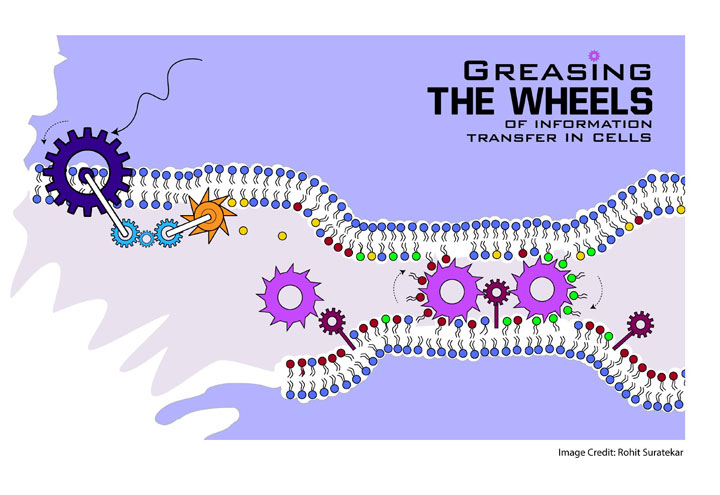Greasing the wheels of information transfer in cells
Mealtimes at a café, a darshini or a dhaba are visible and audible scenes of seeming chaos. However, the storm of shouted orders and responses are actually a pretty good communication system that co-ordinate the serving of food from kitchens, removal of used cutlery and resetting of tables. The interior of a cell is much like a busy eatery in that it also needs seamless information exchange between its various parts - the nucleus that issues orders, the protein manufacturing ribosomes, the lipid factories of the endoplasmic reticulum and the plasma membrane that co-ordinates signalling between the cell and its environment.
New insights into the communication systems within cells have been provided by a group of scientists from the National Centre for Biological Sciences (NCBS, Bangalore), Babraham Institute (Cambridge, UK) and University College London (UK). Their work has uncovered a key factor in the communication network between the plasma membrane and the endoplasmic reticulum - one that is essential in resetting the chemical composition of the plasma membrane after a bout of signalling. The researchers used fruit flies as a model system to investigate the role of a protein named "RDGBα" in maintaining the signalling networks of the plasma membrane within the light sensitive cells of the eyes.
The streams of chemical reactions that occur when light falls on the light sensitive cells or photoreceptors in an eye alter the chemical properties of the plasma membrane. This occurs due to a sequence of events - referred to as the phosphatidylinositol or PI cycle - that occurs in the cell membrane in many other instances. For example, when neurons in the brain adjust their response to stimulation or the cells in our body respond to rising blood sugar after a meal, the PI cycle is set in motion. In all of these settings, a lipid component of the cell membrane, named phosphatidylinositol bisphosphate (PtdInsP2) is broken down enzymatically to release another lipid, phosphatidic acid (PtdOH) as a byproduct. In order to maintain continued signalling, the plasma membrane must restore its chemical composition by continuously replenishing PtdInsP2 and removing the PtdOH produced.
The generation of PtdInsP2 depends on a lipid precursor molecule, phosphatidylinositol (PtdIns), that is produced in another distinct cellular compartment, the endoplasmic reticulum. Since PtdIns and PtdOH are lipids (which belong to the family of fats), they cannot move by simple diffusion through the watery interior of the cell. So, how does the plasma membrane replenish its PtdIns supply and remove the excess PtdOH to maintain homeostasis during this signalling process?
The answer to this lies in the protein RDGBα (retinal degeneration B), which aids in maintaining the chemical integrity and function of the plasma membrane. Fruit flies without RDGBα function have photoreceptors that are defective in responding to light and undergo retinal degeneration on continued exposure to light. Investigations revealed that RDGBα can act as a shuttle moving PtdIns and PtdOH between membranes and this function of the protein is critical for normal photoreceptor structure and function.
One of the salient points about this piece of research is the essential meshing of in vitro biochemistry, cell biology and functional analysis in an intact organism to understand the role of a single protein in supporting plasma membrane properties. Dr. Padinjat Raghu, one of the corresponding authors of the paper states that although previous studies have looked at the function of RDGBα as biochemical reactions in vitro, none have related the outcome of these reductionist analyses to the function of the protein within the complex and crowded confines of a living cell.
"There has been considerable interest in the sequencing of the human genome and unravelling how encoded genes function in in health and disease. For obvious reasons there are limitations to detailed experimental analysis in humans. A recent study on the human equivalent of RDGB in cultured cells has showed that the protein functions in a similar manner to Drosophila RDGB. Therefore, our work demonstrating the importance of this protein in intact functioning flies highlights the value of genetic models such as Drosophila in dissecting human gene function." says Dr. Padinjat.
The process under study is a widely conserved chemical reaction that helps in information transfer in animal cells, and is a part of pathways that are implicated in the mechanism of diseases such as diabetes, tumour development and neurodegeneration. This study helps in revealing how fundamental biochemical processes in cells operate and in the future may help in the developing therapeutic strategies for human or animal diseases.
About the Authors:
Shweta Yadav , Aniruddha Panda and Swarna Mathre are affiliated to the National Centre for Biological Sciences (NCBS), Bangalore.
Kathryn Garner, Michelle Li, Evelyn Gomez-Espinosa and Shamshad Cockcroft are affiliated to the Department of Neuroscience, Physiology and Pharmacology, University College, London, UK.
Plamen Georgiev, Max Planck Institute of Immunbiology and Epigenetics in Freiburg, Germany. Hanneke Okkenhaug, Imaging Facility, Babraham Institute, UK.
Dr. Raghu Padinjat is affiliated to National Centre for Biological Sciences (NCBS), Bangalore.
Contact Information:
Padinjat Raghu: praghu@ncbs.res.in
The paper was published in the Journal of Cell Science on the 1st of September and can be read here.
Anusha Krishnan is a writer with the Research Media Services Division of Gubbi Labs.

Comments
Post new comment